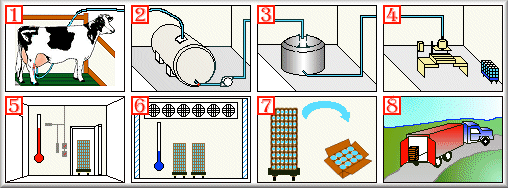|
What's different about Pinehedge Farms Yogourt? |
|
What is organic farming? |
|
Why does the cream rise to the top? |
|
Why use glass jars? |
|
How is organic Yogourt/Kefir actually produced? |
 |
| 1. MILKING: During the summer, our cows remain in pasture, except when we milk them twice a day (a total of about four hours). This ensures wholesome milk production. |
| 2. STORAGE: A 2500 litre tank holds the milk for shipment or for yogourt. When the time comes to make yogourt or kefir, the milk is pumped across to the processing plant via overhead pipeline. |
| 3. PASTEURIZATION: At the processing plant, the incoming milk fills a giant vat and is heated to pasteurization temperature. The culture is added after some cooling and fermentation begins. |
| 4. FILLING: We use glass jars and plastic tubs to store our product. The filling machine is positioned over the containers and set to place a certain amount of the cultured milk into each one. |
| 5. INCUBATION: After the bottles are filled and laid in the trays, they are quickly brought to the incubator, a sealed room with a constant temperature needed for the culture to ferment. |
| 6. REFRIGERATION: After fermentation is complete, the yogourt leaves the incubator and is put in cold storage. This ensures stabilization of the culture. It is kept here, then packaged and stored until shipment. |
| 7. PACKAGING: When the cultures have stabilized after the cooling, we pack the jars and plastic tubs into boxes to await distribution. |
Here's what some of our customers have said about our products.
If you have any questions or comments about this page, please contact us.
This
website copyright © 1998-99 Pinehedge Farms, ALL RIGHTS RESERVED.
All original graphics copyright © Chris Cull 1998.
design and hosting